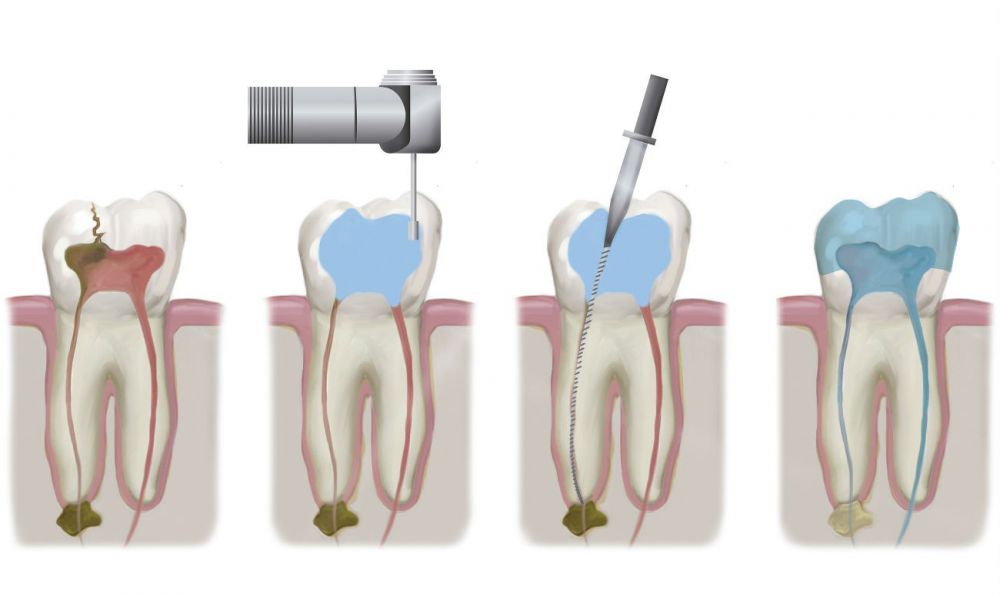Root Canal Revision in Torrevieja
Root Canal Retreatment in Torrevieja
Table of Contents:
Why is root canal retreatment necessary for a tooth that has already been treated before? Factors on which the need for retreatment depends. Diagnostics and detection of the need for retreatment. How is retreatment performed?
Features of root canal treatment at the "AP-Denta" clinic. What to do after root canal retreatment (recommendations).
Why is root canal retreatment necessary for a tooth that has already been treated before? Sometimes previous treatment turns out to be ineffective and/or does not meet modern quality standards. For example, in the following cases:
- There is a "cyst", but the tooth tissues are in good condition and it is possible to save the tooth and avoid extraction and implantation.
- A crown needs to be placed on the tooth, but there are signs of poor previous treatment or reinfection.
Factors on which the need for retreatment depends: You can read more about retreatment when there is a "cyst" (inflammation) in the "Cyst Treatment" section.
And when there is no "cyst", the question arises - why then should treatment be repeated?
If it is radiologically revealed that the previous endodontic treatment was carried out poorly, but the tooth is covered with a crown, there are no problems with this tooth, and there are no signs of inflammation at the apices, then of course, retreatment is not needed.
But if the tooth is not covered with a crown, and restoration with a crown is only planned, then in such cases, the need for re-intervention is decided individually during the consultation, and depends on many factors.
The main goal of endodontic treatment is to prevent or cure apical periodontitis. And during the consultation, the doctor makes a diagnosis and if he sees that the previous poor quality root canal treatment can cause periodontitis after the placement of the crown, then the intervention is performed.
Diagnostics and detection of the need for retreatment: For thorough diagnostics and detection of the need for this intervention, we use dental CT scans (CT scans of only one tooth) at our clinic. This is a very high resolution 3D X-ray scan with very precise detailing. It makes it possible to examine tooth roots from all angles.
How is retreatment performed? And if the doctor decides that retreatment is necessary, it is usually completed in one to two visits and consists in carefully following a certain sequence of actions:
First, after local anesthesia, the doctor isolates the tooth with a special latex patch called a rubber dam. This is necessary to prevent saliva contaminated with bacteria from entering the tooth during treatment.
Secondly, the doctor accesses the root canals, removes affected tissues, old fillings and materials from the root canal, all contaminants, processes the canals with special rotating machine tools and ultrasound.
Thirdly, the doctor thoroughly disinfects the root canals with antiseptic solutions. These solutions must be inside the tooth for at least 40 minutes for effective treatment, which is why this procedure takes a long time.
And fourthly, if the treatment is performed in one visit, the doctor fills the root canals with a sealing material to ensure a stable long-term result. If necessary, the doctor places a temporary medicine inside the tooth that has a disinfecting and anti-inflammatory property. Sometimes such medicine has to be left in the tooth several times. And only then are the channels permanently sealed.
Features of root canal treatment at the "AP-Denta" clinic: Previously, a paste based on resorcinol-formaldehyde was used to seal root canals, which gave the teeth a brownish tint. In Spain, this method is prohibited due to its toxicity and carcinogenicity. The sealing of root canals with zinc and eugenol paste has also become a thing of the past.
In our clinic, for the treatment of root canals, we use the “gold standard” of modern endodontics – machine canal preparation, gutta-percha, and sealants.
In addition to this, during retreatment, we always use a dental microscope, which significantly improves the quality of treatment. With its help, it is possible to find all the canals, see areas inaccessible to the human eye, clean all contaminants.
What to do after root canal retreatment?
(see memo)
After root canal treatment, a temporary or permanent filling is usually placed. But the tooth becomes fragile and prone to fractures. Therefore, after endodontic treatment, the tooth must be covered with a crown or veneer.
And subsequently, it is necessary to come for checkups every 6 months in order to monitor the dynamics of the condition.
Memo after root canal treatment We invite residents of Torrevieja, La Mata, Elche, Murcia, Alicante and other cities of the Costa Blanca region and Valencia region to visit our clinic or call tel. CALL: +(34) 638 893 141 Appointments by preliminary arrangement.
Contact Information:
| Torrevieja, Pasaje Pais Vasco, edificio 1 local 4 | |
| +(34) 638 893 141 | |
| +(34) 638 893 141 | |
| apdenta@gmail.com | |
| Working hours: Mon - Fri: from 10:00 to 20:00 |




